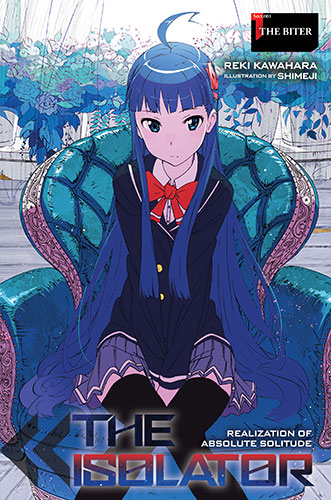By Reki Kawahara and Shimeji. Released in Japan by ASCII Mediaworks. Released in North America by Yen On.
The first volume of this series introduced us to Minoru, a broken young man who wishes to live his live with minimal emotional contact with anyone – and has secret suicidal thoughts. In this second book, he seems much better, even if the reason for that is because he hopes to achieve his goal, which is to erase the memory of him from everyone who knows him. Of course, as he finds out, this is not going to be as easy as he thought. Even those who already had their memories erased, such as last volume’s victim Tomomi, still feel drawn to him for reasons other than memory. And, as he grows closer and bonds with the new Superhero Organization he’s a part of, he finds that new emotional experiences are just impossible to avoid.
It’s rather surprising how serious-minded this book is. Sword Art Online has lots of amusing comedy bits sprinkled throughout, and even Accel World throws in some light relief from Haru’s worrying and low self-esteem. The Isolator is grim, though, and even the odd joke or two (such as Olivier’s otaku-ish jokes) highlights how depressing everything here is. We meet the team leader of the troop, and she’s… a fourth-grader whose black gem gave her super analysis powers, so she’s now a scientific genius. Bored as I am of the ‘loli genius with an adult’s mindset’ type in this sort of series, the book does not let you forget that this was still an elementary school girl, and due to the nature of how gem powers work my guess is she was doing badly in school as well. I suspect she’s not a happy camper.
But the winner of the bleakest past here goes to Yumiko, who I had mentioned last time looked like she had hidden depths. Indeed, I think Kawahara overeggs the pudding here, as we get not one but *two* tragic backstories. It does serve to show Minoru, though, that he is not a special tragedy snowflake, and remind him that there are other ways to cope with grief and loss besides isolation. As with the first volume, the villain also gets a well-thought out backstory. Sadly, though, his personality is identical to all of Kawahara’s other psychopaths – you can give depth and tragic history all you want, but when the villain in the end is still laughing madly and going on about fools and his grand plan to destroy the world, it’s still not working.
The best reason to read this series is still the action scenes, which cry out to be animated at some point in the future. I’m not sure where the series is going from here – the book ends very abruptly, as if the author was working to a set page count. But I do know that while it’s gripping and a quick read, I wish it were more fun. I feel like isolating myself after reading it.



